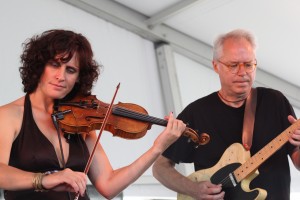My new CityArts-New York column covers some of what went down at the 2012 Newport Jazz Festival. With three stages running staggered but near-simultaneous performances, there was much too much happening to hear it all (I’ve been listening to some of what I missed, like Bill Frisell’s modern string band tribute to John Lennon, at NPRMusic where live recordings are archived).
Due to space limitations, some of my notes about music I wasn’t completely thrilled with were edited out. Here’s what’s missing from the article as published (my positive comments are retained in the column):
Guitarist Pat Metheny’s Unity Band put on a show of over-the-top, overly trebly force. Acclaimed young trumpeter Ambrose Akinmusire, with his equally young quintet, seemed to propose a personal horn vocabulary of fast register leaps and high smears, but I didn’t get his fundamental material, beyond the influence of Miles Davis circa 1967.
Saxophonist James Carter ripped raunchily through generic organ trio soul tunes, but lost me with his singer, Ms. Miche Braden. And Tedeschi Trucks Band, the rock, roots ‘n’ blues troupe that ended the fest, was of scant interest to most attending music journalists. One song I heard seemed lifted from The Band’s “You Don’t Know The Shape I’m In.” It wasn’t clear that this supposed crowd-pleaser drew its own fans to the fest.
After I wrote that, I had some other thoughts, mostly regarding context:
It also wasn’t clear that of any importance to producer Wein and company. The Newport Jazz Festival is, after all, an established institution now, unlike at its founding, when the very idea of bringing African-American musicians to the quaint town where the nouveau rich had built lavish mansions back in the Guilded Age – America in the 1890s – was transgressive. Backed by heirs to a tobacco fortune, young George Wein, who ran a jazz club in relatively nearby Boston, hired the cream of 1950s talents. Jazz was then at its full glory as the sophisticated popular music for upwardly mobile adults.
The fest’s debut lineup in 1954 comprised Stan Kenton, Eddie Condon, Lee Wiley, the Modern Jazz Quartet, Oscar Peterson’s trio, Billie Hiliday, Dizzy Gillespie, Gerry Mulligan, a tribute to Basie with Lestery Young, Jo Jones and Teddy Wilson among others, George Shearing, Errol Garner, Lennie Tristano with Lee Konitz, Gene Krupa, Ella Fitzgerald. In ’55 the stars were Louis Armstrong, Clifford Brown-Max Roach, Roy Eldrige and Coleman Hawkins, Woody Herman’s Orchestra Dave Brubeck, Dinah Washington, Marian McPartland, Chet Baker, Ellington and Basie himself. New York’s rising jazz record producers such as George Avakian and the Ertegun brothers along with booking agents, managers, club owners and journalists came to cool Newport for a break from steamy (unairconditioned) Manhattan, hobnobbed informally with the musicians and made their deals for the coming year.
It was fashionable to be there, and productive – and so Wein started the Newport Folk Festival in 1959, which in the ’60s overshadowed the Jazz Fest as a predecessor of the rock fests to come (Monterey Pop Festival, Woodstock, Ann Arbor Blues and Folk Fests, Altamont, etc.). From that, Wein developed an empire, producing fests throughout the U.S. and in Europe, too.
He’s had major triumphs and setbacks: A youth riot in Newport leading to expulsion from the town in 1971; the rebirth holding Newport in New York Fests sponsored by Kool cigarettes; a 24-year- agreement with the consumer electronics firm JVC to back his festivals, which ended in 2008; sponsorship scarcity since then his just-begun commitment from Natixis Global Asset Management of three years support. It’s not clear always clear what such sponsors get from underwriting jazz festivals, besides name recognition (admittedly, I am now well disposed to having Natixis manage all my global assets). With the funding, however, there seems to be less urgency in drawing ticket buyers, which allows the programming Melnick devises with Wein’s consultation to be somewhat removed from market considerations.
So there is no pop-jazz at Newport (other than Tedeschi-Trucks), no smooth singers or commercial fusion, and little music that’s rap or hip-hop related. The jazz business is not in the upsurging mode it was in the mid ’50s – record companies now barely exist, and no execs come to Newport to scout potential signings. The musicians playing at Newport 2012 were known already to the upper echelon jazz activists in New York, and indeed many of them are also performing at the Monterey Jazz Festival in California, September 21 through 23.
It might be ironic that the fest has a fresh feeling to it, and gives lip service to wanting new audiences, while even the youngest leader on the bandstand, Akinmusire, is 30, and the overall esthetic concept almost everyone’s pursuing is about reconciliation with the past rather than proposal of a daring new future.
Reconciliation, proposal or simply a lovely weekend of music, friends and ease near the water, the Newport Jazz Festival remains a pleasure not to be taken for granted.

